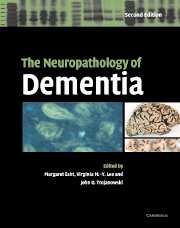Book contents
- Frontmatter
- Contents
- List of contributors
- List of abbreviations
- Preface to second edition
- 1 Definition, clinical features and neuroanatomical basis of dementia
- 2 Important anatomical landmarks in the brain in dementia
- 3 Practical approach to pathological diagnosis
- 4 Morphometric methods and dementia
- 5 Safety precautions in laboratories involved with dementia diagnosis and research
- 6 Molecular diagnosis of dementia
- 7 Neuropathology of the ageing brain
- 8 Neuroimaging Alzheimer's disease
- 9 Alzheimer's disease
- 10 Down's syndrome and Alzheimer's disease
- 11 Sporadic tauopathies: Pick's disease, corticobasal degeneration, progressive supranuclear palsy and argyrophilic grain disease
- 12 Hereditary tauopathies and idiopathic frontotemporal dementias
- 13 Vascular dementias
- 14 Familial and sporadic cerebral amyloid angiopathies associated with dementia and the BRI dementias
- 15 Parkinson's disease, dementia with Lewy bodies, multiple system atrophy and the spectrum of diseases with α-synuclein inclusions
- 16 Huntington's disease
- 17 Human prion diseases
- 18 Alcoholism and dementia
- 19 Hydrocephalus and dementia
- 20 Head injury and dementia
- 21 Infectious (and inflammatory) diseases causing dementia
- 22 Schizophrenia and its dementia
- 23 Other diseases that cause dementia
- 24 Transgenic mouse models of neurodegenerative disease
- Appendix: Dementia brain banks
- Index
17 - Human prion diseases
Published online by Cambridge University Press: 12 October 2009
- Frontmatter
- Contents
- List of contributors
- List of abbreviations
- Preface to second edition
- 1 Definition, clinical features and neuroanatomical basis of dementia
- 2 Important anatomical landmarks in the brain in dementia
- 3 Practical approach to pathological diagnosis
- 4 Morphometric methods and dementia
- 5 Safety precautions in laboratories involved with dementia diagnosis and research
- 6 Molecular diagnosis of dementia
- 7 Neuropathology of the ageing brain
- 8 Neuroimaging Alzheimer's disease
- 9 Alzheimer's disease
- 10 Down's syndrome and Alzheimer's disease
- 11 Sporadic tauopathies: Pick's disease, corticobasal degeneration, progressive supranuclear palsy and argyrophilic grain disease
- 12 Hereditary tauopathies and idiopathic frontotemporal dementias
- 13 Vascular dementias
- 14 Familial and sporadic cerebral amyloid angiopathies associated with dementia and the BRI dementias
- 15 Parkinson's disease, dementia with Lewy bodies, multiple system atrophy and the spectrum of diseases with α-synuclein inclusions
- 16 Huntington's disease
- 17 Human prion diseases
- 18 Alcoholism and dementia
- 19 Hydrocephalus and dementia
- 20 Head injury and dementia
- 21 Infectious (and inflammatory) diseases causing dementia
- 22 Schizophrenia and its dementia
- 23 Other diseases that cause dementia
- 24 Transgenic mouse models of neurodegenerative disease
- Appendix: Dementia brain banks
- Index
Summary
Introduction
Prion diseases (also known as transmissible spongiform encephalopathies) are fatal neurodegenerative diseases occurring in a wide range of mammals, including humans (for review see Prusiner, 1998). The first of these diseases shown to be transmissible under experimental conditions was scrapie, a disease of sheep and goats, which is endemic in the UK, North America and many countries in Europe. Since then, much of the work to identify and characterize the transmissible agents responsible for this unique group of disorders has been performed on the scrapie agent. Prion diseases are unique amongst human neurodegenerative disorders in that they occur in sporadic, familial and acquired forms (Ironside, 1996; Prusiner, 1998). The clinical manifestations of human prion diseases frequently include dementia, but a wide range of other neurological abnormalities may also occur (Will et al., 1999). Accordingly, the range of neuropathological abnormalities in these diseases is broad, but four cardinal features occur: spongiform change (vacuolation of the grey matter and occasionally neurons), neuronal loss, gliosis and the accumulation of an abnormal isoform of a host encoded protein, the prion protein (Ironside, 1998). This abnormal protein can accumulate as amyloid plaques in some cases, but most examples of human prion diseases do not contain amyloid plaques and the accumulation of the abnormal form of the prion protein can only be detected by immunocytochemistry or Western blot techniques (see Appendices).
The transmissible agent responsible for prion diseases is different from other conventional organisms associated with infectious diseases in humans and other species. Although the precise nature of the transmissible agent is not fully understood, there is a large and increasing body of evidence to favour the prion hypothesis (Prusiner, 1982).
- Type
- Chapter
- Information
- The Neuropathology of Dementia , pp. 402 - 426Publisher: Cambridge University PressPrint publication year: 2004
- 1
- Cited by

